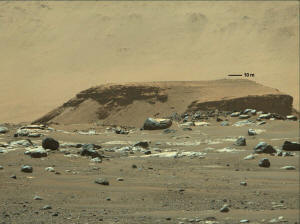Mars long ago was wet. You may be surprised where the water went
 Send a link to a friend
Send a link to a friend
 [March 18, 2021]
By Will Dunham [March 18, 2021]
By Will Dunham
WASHINGTON (Reuters) - Mars was once a wet
world, with abundant bodies of water on its surface. But this changed
dramatically billions of years ago, leaving behind the desolate
landscape known today. So what happened to the water? Scientists have a
new hypothesis.
Researchers said this week that somewhere between about 30% and 99% of
it may now be trapped within minerals in the Martian crust, running
counter to the long-held notion that it simply was lost into space by
escaping through the upper atmosphere.
"We find the majority of Mars' water was lost to the crust. The water
was lost by 3 billion years ago, meaning Mars has been the dry planet it
is today for the past 3 billion years," said California Institute of
Technology PhD candidate Eva Scheller, lead author of the NASA-funded
study published on Tuesday in the journal Science.

Early in its history, Mars may have possessed liquid water on its
surface approximately equivalent in volume to half of the Atlantic
Ocean, enough to have covered the entire planet with water perhaps up to
nearly a mile (1.5 km) deep.
Water is made up of one oxygen and two hydrogen atoms. The amount of a
hydrogen isotope, or variant, called deuterium present on Mars provided
some clues about the water loss. Unlike most hydrogen atoms that have
just a single proton within the atomic nucleus, deuterium - or "heavy"
hydrogen - boasts a proton and a neutron.

[to top of second column]
|

A tall outcropping of rock, with layered deposits of sediments in
the distance, marking a remnant of an ancient, long-vanished river
delta in Jezero Crater, are pictured in this undated image taken by
NASA's Mars rover Perseverance from its landing site, and supplied
to Reuters on March 5, 2021. NASA/JPL-Caltech/Handout via REUTERS

Ordinary hydrogen can escape through the atmosphere into space more
readily than deuterium. Water loss through the atmosphere, according
to scientists, would leave behind a very large ratio of deuterium
compared to ordinary hydrogen. The researchers used a model that
simulated the hydrogen isotope composition and water volume of Mars.
"There are three key processes within this model: water input from
volcanism, water loss to space and water loss to the crust. Through
this model and matching it to our hydrogen isotope data set, we can
calculate how much water was lost to space and to crust," Scheller
said.
The researchers suggested that a lot of the water did not actually
leave the planet, but rather ended up trapped in various minerals
that contain water as part of their mineral structure - clays and
sulfates in particular.

This trapped water, while apparently plentiful when taken as a
whole, may not provide a practical resource for future astronaut
missions to Mars.
"The amount of water within a rock or mineral is very small. You
would have to heat a lot of rock to release water in an appreciable
amount," Scheller said.
(Reporting by Will Dunham, Editing by Rosalba O'Brien)
[© 2021 Thomson Reuters. All rights
reserved.] Copyright 2021 Reuters. All rights reserved. This material may not be published,
broadcast, rewritten or redistributed.
Thompson Reuters is solely responsible for this content. |